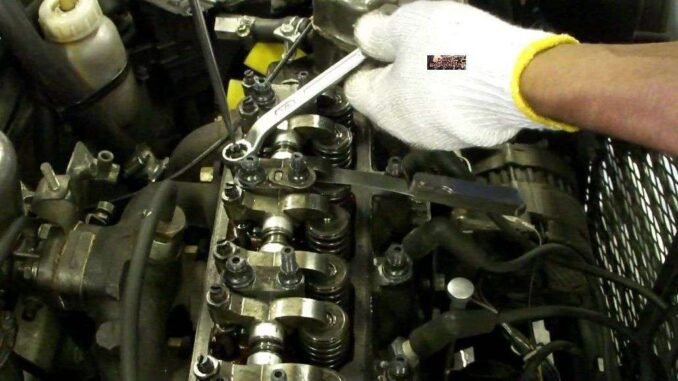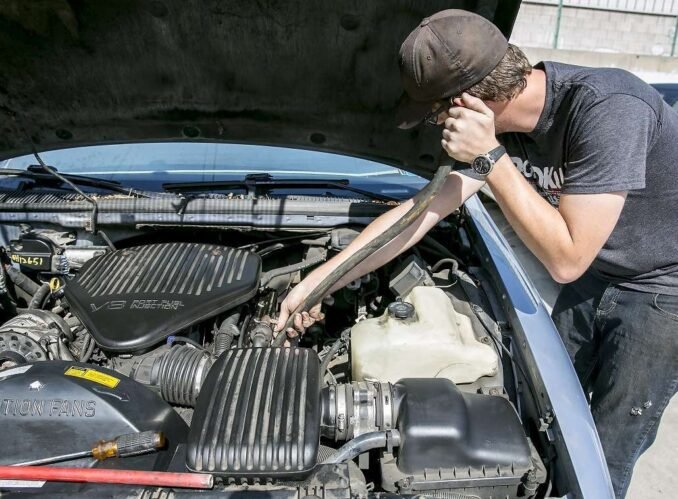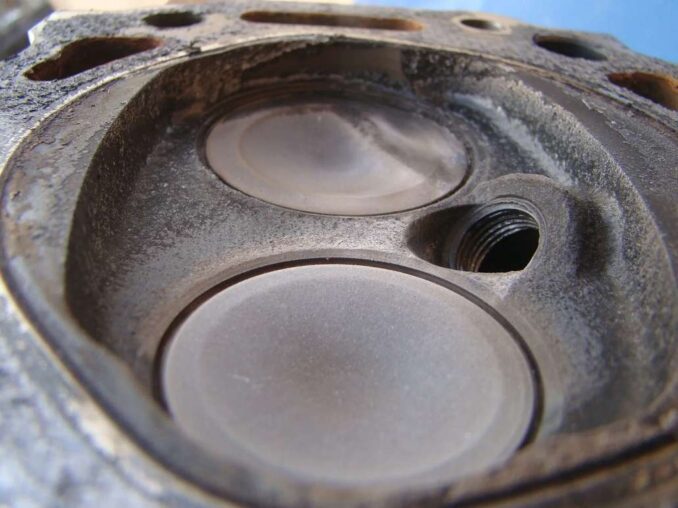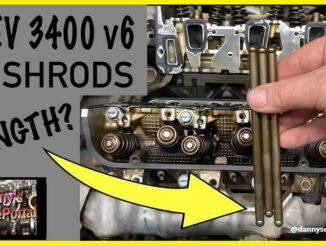
The term “valve lash” is often used when talking about, valve train adjustment.
A valve lifter follows the contour of the camshaft lobe, and transfers that motion to open and close the valves. (sometimes referred to, as a tappet or cam follower).
Valve lash adjustment is a necessary maintenance requirement, for engines without hydraulic valve lifters.
Valve Lash, is needed so the metal parts of the valve train, can expand when they warm up. And, still not move the valves in any way.
So, Let’s Start With Understanding The Basics Of, What Valve Lash Is
A solid lifter is a rigid component. In contrast, a hydraulic lifter is designed to accommodate for variations in valve train clearance. In order to automatically maintain zero lash in the valve train, under all operating conditions.
It does this by filling and emptying the lifter with engine oil, through a metering orifice, and a check valve. When the lifter is filling with oil, it is pumping up. When the oil is exiting the lifter, it is bleeding or leaking down.

Solid lifters have a predetermined amount, of lash or clearance. An engine equipped with a hydraulic camshaft, does not require a feeler gauge.
But, Not All Engines With Hydraulic Valve Lifters, Have A Preload Adjustment
If the rocker arm is stud mounted, such as on a Chevy, then proper procedure involves, attaining zero lash. Plus the specified amount of preload. Some engine designs, such as the Pontiac V-8, use a stud. But, are considered non adjustable in factory form.
On these engines, the rocker stud needs to be changed, to make the valve train adjustable with a hydraulic camshaft.
Other designs use a pedestal mount for the rocker, and may require shims. Some engines, including Buick V-6s and V-8s and many Chrysler V-8s, use shaft mounted rocker arms. With this arrangement, the shaft mounting bolts are torqued to a designated spec. If the valve train is noisy, there is a wear issue, or mechanical problem.
A Hydraulic Valve Lifter Offers Several Advantages:
- No more maintenance valve adjustments.
- Quieter operation, due to having no valve lash.
- Longer valve and cam life, due to eliminating the pounding of a solid lifter.
- Smoother engine operation, due to precise valve control.
- Automatic compensation for expansion and contraction of the valve train parts, caused by temperature change.
So, How Does A Hydraulic Valve Lifter Actually Work
To understand how the hydraulic valve lifter is able to accommodate, valve train slack while maintaining zero lash. We need to look at, its inner workings.

When the valve is closed, the plunger spring in the hydraulic lifter, takes up all clearance in the valve train. Oil enters the lifter body through feed holes, and flows inside to the plunger. The oil continues to flow down through the hole in the bottom of the plunger, and around the check valve. Then, through the holes in the check valve retainer, to completely fill the cavity below. As the lifter begins to ride up the cam lobe. The oil below the plunger, tries to escape past the check valve.
This sudden flow of oil forces the check valve to seat, which seals the hole at the bottom of the plunger. The full load of the valve train is now on the lifter. The lifter now acts almost as if it were, a solid design.
A predetermined and closely held clearance, between the lifter’s plunger and its body. Also, permits a minute amount of oil to escape from below, moving past the plunger. This movement of the plunger with respect to the lifter body after the check valve is seated. Is called leak down or bleed down. Consequently, it consists of the oil draining out. Valve lash.
As the lifter returns to the base circle of the camshaft, oil fills the high pressure cavity, and the cycle begins again.
When the engine temperature change requires shortening the lifter’s effective length, a hydraulic lifter automatically compensates. Because, the valve spring forces the plunger down. The return spring raises the plunger, when lengthening of the lifter is required . This causes more oil to flow, into the spring cavity.
A Hydraulic Valve Lifter Also Has Some, Disadvantages
Another potential drawback of hydraulic lifters is that, at very high engine speeds. The valve train inertia may open the valves further than intended.
Understanding Valve Train Noise – Excessive Valve Lash
Valve train mechanism noise is similar to a ticking sound, of a sewing machine. The sound frequency of the valve train noise is, one half the crankshaft speed. A clicking lifter, is one very common valve train noise. This is because the amount of lash or free play is excessive. If the engine has hydraulic valve lifters, however, a number of things could be wrong.
The problem with diagnosing and correcting valve train noise, is that there are many components that can cause undesirable sounds.
Other Things That Can Cause Valve Train Noise Are:
- Sticky valves
- Weak springs
- Excessive revving of the engine
In any hydraulic application, another cause can be the result of, machining of the cylinder head and valve seats. Because, this changes the rocker arm geometry.
Many Mechanics Think That This Is Caused By, Faulty Hydraulic Lifters. But, That Is Not Always Correct
The lifter is only responding to the conditions, and trying to adjust for them. That’s why it is critical to make sure that the valve train is the culprit. When chasing any excessive noise, before it becomes a major issue. Valve lash.

It is important to remember that, several different conditions can produce a noise identical to that caused by a failed or failing valve lifter. Some of these conditions are:
- Lack of lubrication, between the rocker arm and the pushrod.
- Lack of lubrication, between the rocker arm, and the end of the valve stem.
- Excessive valve guide to valve stem clearance.
- Badly worn valve tips, and/or rocker arm pads.
- Worn camshaft lobes.
- A loose valve seat on heads with inserts.
- A warped valve.
- Excessive clearance, between the lifter, and the lifter bore hole in the block.
- A loose rocker arm shaft.
- A broken valve spring.
Consequently, if the engine noise is not caused by one of the listed issues, then it is coming from a failed lifter.
You will need to find the bad lifter. A simple method is to use a piece of garden hose. Remove the valve covers. With the engine running, place one end of the hose near the spring retainer of each intake and exhaust valve. Then, put the other end of the hose, to your ear. It will be very apparent which is the bad valve lifter.

Another method is with the engine off push down on each of the rocker arms on the pushrod side. If the rocker arm is free to move or there is a spongy feeling. Then, it is a good indicator that the valve lifter is leaking down too fast, or not retaining oil.
Once you locate the lifter that is causing the noise, you will need to determine the reason for its malfunction.
So, There Are Four Types Of Noise. And, Most That Can Be Caused By, An Inoperative Or Failing Valve Lifter:
1- A Loud, Rapping Sound
This can be caused by the plunger, being stuck in the valve body. Usually due to excessive varnish, between the plunger and body. Also, by dirt or other foreign materials wedged, between the plunger and body. Another cause of a loud rapping sound is, a very worn base or foot, on the lifter itself.
2- Moderate Clicking Noise, valve lash
This can be the result of varnish, or a worn lifter bottom. The noise level depends on the amount of varnish, and the degree of wear. Two other causes of a moderate clicking noise are, very fast or slow leakdown.

Slow leakdown generally will cause the engine to be noisy, only when cold and the oil is thick. With fast leak down, the valve train will be noisy, when the engine is warm. Fast leakdown will also occur if the ball check in the lifter fails to seal.
3- An Intermittent Clicking
This type of noise is hard to locate by its very nature. There will be a few clicks, and then it will be quiet. But, the noise will come back after a short period of time. The usual cause of intermittent clicking, is a very minute piece of dirt. Because, that holds the ball check off the seat for a few seconds, and then passes through.
4- General Valve Train Noise
When the sound is throughout the entire valve train. The cause is usually the weight of the oil, or the oil supply itself. Too much oil in the crankcase will cause foaming and aeration. When air gets into the lifters, they will fail to operate properly.
Insufficient oil supply to the lifters can also cause general valve train noise. This could be the result of too little oil in the crankcase. An oil pump not operating properly, or clogged main oil gallery lines.
Correcting The Noise And The Steps To Making It Right – Valve Lash
Part 1 Valve Lash
The first step in fixing valve train noise and creating the correct valve events. Is recognizing that valve train parts are consumables. All too often, I hear of someone is rebuilding an engine. But, is reusing all of the rocker arms, lock nuts, valve springs, pushrods and other components.
Even if you’re only trying to quiet the valve train, not rebuild your engine, you need to examine every component. You can only properly adjust the valve train, after removing and closely scrutinizing each part. Usually, the rocker arms, pushrods and valve stems. (the cylinder heads do not need to come off at this point).
If the lash on one valve seems very loose or tight, there is something wrong.
Sucked In Exhaust Valve Seat, Service the heads or you may drop a valve. The best approach when adjusting the valves on any engine. Is, to remove the valve train parts to study them, while noting their location. You want each part going back on where it came from. This is due to wear patterns.
Part 2 Valve Lash
My suggestion is that if the engine has been in service for many years. Then, it is best to install new lifters, rocker arms, bolts, pushrods and lock nuts. These are inexpensive parts, and you shouldn’t hesitate to replace them. This way, everything is new when you perform the final adjustment. And, the valve train should be nice and quiet, and not pose a threat to the engine.
Some engines use rocker shafts or a bridge between the valves (like on some Oldsmobiles).
To get the preload correct, you may have to install shims. As always, it is best to familiarize yourself with the proper steps from a factory shop manual. There are many different thoughts on how to position the valves, when adjusting an engine with rocker studs. Some manuals tell you to mark the balancer. Then, jump around to different cylinders, that have the lifter on the base circle of the cam.
Part 3 Valve Lash
Personally, I find that method burdensome. It is often hard to see the balancer on newer engines. I do not like moving all my tools and my fender cover from side to side. And, it gives the lifters a chance to bleed down, more than I would like.
The method that I use is to use a helper or a jumper switch to bump the starter, until the cylinder I am working on has both valves closed. Then I am sure the lifters are on the base circle.

Once the lifters are positioned properly, try to twist the rocker arm from side to side, to check for play. If all looks good, loosen the lock nut slightly, while trying to twist the pushrod, between your fingers. When the push rod starts to turn, stop loosening the nut.

Then start tightening the nut, while twisting the pushrod, between your fingers. When the pushrod will no longer turn, you’ve reached zero lash. Now turn the nut between one half and one full turn, to set the preload. Follow the same procedure on the other valve, and then move on to the rest of the cylinders.
Conclusion
Start the engine with the rocker covers off, or with the covers just dropped in place. Listen for any noise, and recheck the oil flow to the rocker arms. If done properly, the engine should be smooth, quiet and powerful.
Eliminating valve lash clatter, is one benefit of adjusting the clearance. Also, the engine will likely become, smoother and more responsive. In addition, correct clearance can extend the life of the valve system.
BY DANNY BENDER





